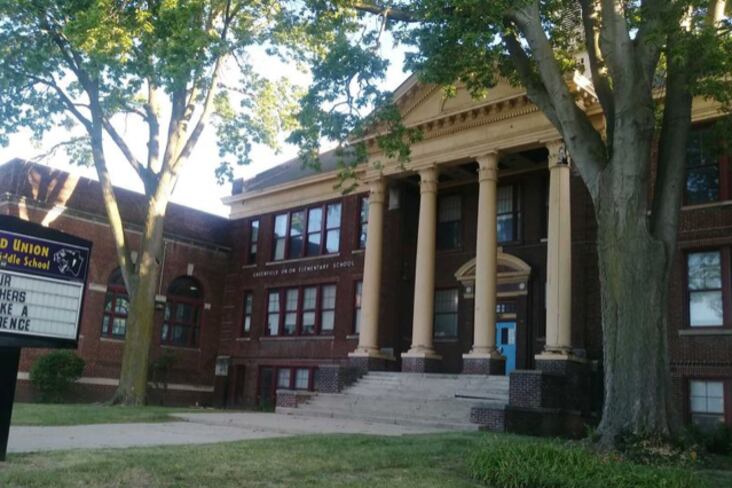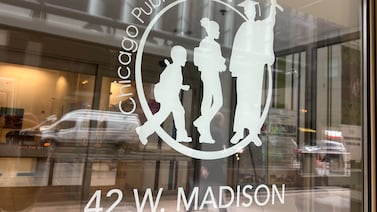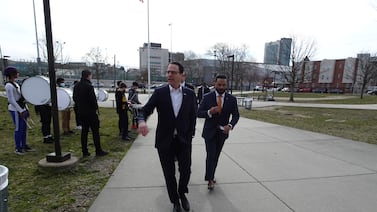Virtual assemblies. Eating lunch in the classroom. Sitting six feet apart.
These are just some of the changes students might experience when the Detroit school district welcomes nearly 51,000 students back to virtual or physical classrooms on Sept. 8.
While the changes are creating challenges, district superintendent Nikolai Vitti said the district will still be able to serve its students whether they start the year learning remotely or in person.
Some schools in the district are going fully remote by subject, grade level, or the entire school building. If parents are unable to stay home with their child, they can send them to one of the district’s learning centers, where students can take online classes at schools with support staff supervision.
Because of the COVID pandemic, the district is allowing families to switch between face-to-face and virtual learning each quarter. Many families have struggled to choose between learning options as they balance health concerns and their children’s learning needs.
“We are all working as hard as possible to provide the best education we can to our students — [face-to-face] or online. These are less than ideal conditions for learning. We are confident that we have made the right investments to ensure students can learn [face-to-face] or online based on their selection,” Vitti said.
Students will receive class schedules this week, Vitti said. Instruction will focus on core subjects — math, English language arts, science, and social studies — and schools will offer some electives. Schools and learning centers will also provide meals. Students will have access to mental health support services.
What will the first day of school look like for Detroit district students learning remotely, inside a physical classroom, or virtually at a learning center? Read on to find out.
Online learning at home
The virtual school day will still have structure and classroom expectations, just as if students were sitting in a classroom desk.
Principals will hold virtual assemblies at the start of each day to check in with teachers, students, and families.
“This is important to maintain a sense of community within the school, discuss logistics, and ensure a routine is established,” Vitti said.
On the first day of classes, online students will log into their first class in Microsoft Teams, the video conferencing platform teachers will use for live instruction.
Teachers expect online students to log in a few minutes early in case of technical issues, so class can start on time. Each student’s device must be fully charged before class starts, and students will need to keep their cameras on while class is in session unless directed otherwise.
Online classes will follow the same school schedule as face-to-face classes. Teachers will take daily attendance, give assignments, and hand out grades. Each class will include live instruction and time to work independently or in small groups. Each student will have five to six minutes of transition time between courses each day.
Online students will still have a lunch period and can pick up a meal at one of the district’s grab-and-go sites.
Teachers can post announcements and schedules and create assignments on Schoology, a learning management system the district uses. Teachers must inform families 10 days in advance if there are any changes to a student’s online schedule.
Families can access these schedules by logging into PowerSchool, an online portal where parents can view progress reports, attendance records, report cards, transcripts, and other student information.
The district is offering parent training throughout the year to support student learning from home. Families can get extra help through the district’s Homework Hotline at 1-833-466-3978 starting Sept. 14 between 5 and 8 p.m. Monday through Thursday.
Face-to-face classes
Students learning in person should expect major changes as schools implement COVID-safety measures. When they first arrive on campuses, staff will check their temperatures before they can enter the building. There will be daily health screenings for students and staff, lots of available hand sanitizer, and schools will be regularly cleaned.
There won’t be as many people inside the buildings, and schools might open more entrances for the arrival and dismissal of students. Each school can modify schedules to limit the number of students moving in the building at one time.
Students will be staying inside their classroom during the school day while teachers come to the class. There will be no more than 20 students inside each classroom, and desks will be separated 6 feet apart to adhere to social distancing. Some high schools may conduct classes in cafeterias or auditoriums to further separate students. Students who receive school meals will eat them in their classrooms.
Older students will be expected to wear face masks during classes. There are exceptions for younger students and those with medical conditions. The district has updated its student code of conduct to include disciplinary actions for students who do not follow safety measures. Not wearing a mask in class could lead to a parent-teacher conference.
Learning centers
If a student still wants in-person supervision and be in a classroom, they can attend one of the district’s learning centers. The centers are available at all school buildings at no cost.
“Some parents and families are not in a position to directly support their children learning online throughout the day at home,” Vitti said.
At the centers, students can take their online classes inside a classroom supervised by a school staff member. The district will provide bus transportation to the learning centers. There will be scheduled breaks, meals, and recess.
City Year, an academic support agency that works with district schools, will be providing subject tutoring and social and emotional support services inside school buildings.







